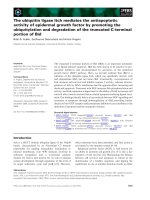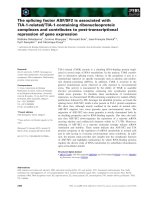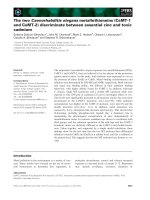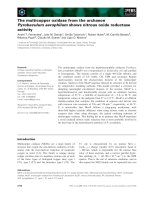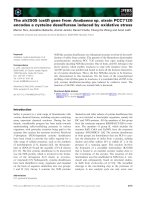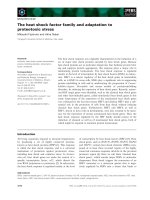Tài liệu Báo cáo khoa học: "The Software Architecture for the First Challenge on Generating Instructions in Virtual Environments" docx
Bạn đang xem bản rút gọn của tài liệu. Xem và tải ngay bản đầy đủ của tài liệu tại đây (798.23 KB, 4 trang )
Proceedings of the EACL 2009 Demonstrations Session, pages 33–36,
Athens, Greece, 3 April 2009.
c
2009 Association for Computational Linguistics
The Software Architecture for the
First Challenge on Generating Instructions in Virtual Environments
Alexander Koller
Saarland University
Donna Byron
Northeastern University
Justine Cassell
Northwestern University
Robert Dale
Macquarie University
Johanna Moore
University of Edinburgh
Jon Oberlander
University of Edinburgh
Kristina Striegnitz
Union College
Abstract
The GIVE Challenge is a new Internet-
based evaluation effort for natural lan-
guage generation systems. In this paper,
we motivate and describe the software in-
frastructure that we developed to support
this challenge.
1 Introduction
Natural language generation (NLG) systems are
notoriously hard to evaluate. On the one hand,
simply comparing system outputs to a gold stan-
dard is not appropriate because there can be mul-
tiple generated outputs that are equally good, and
finding metrics that account for this variability and
produce results consistent with human judgments
and task performance measures is difficult (Belz
and Gatt, 2008; Stent et al., 2005; Foster, 2008).
On the other hand, lab-based evaluations with hu-
man subjects to assess each aspect of the system’s
functionality are expensive and time-consuming.
These characteristics make it hard to compare dif-
ferent systems and measure progress.
GIVE (“Generating Instructions in Virtual En-
vironments”) (Koller et al., 2007) is a research
challenge for the NLG community designed to
provide a new approach to NLG system evalua-
tion. In the GIVE scenario, users try to solve
a treasure hunt in a virtual 3D world that they
have not seen before. The computer has a com-
plete symbolic representation of the virtual envi-
ronment. The challenge for the NLG system is
to generate, in real time, natural-language instruc-
tions that will guide the users to the successful
completion of their task (see Fig. 1). One cru-
cial advantage of this generation task is that the
NLG system and the user can be physically sepa-
rated. This makes it possible to carry out a task-
based evaluation over the Internet – an approach
that has been shown to provide generous amounts
Figure 1: The GIVE Challenge.
of data in earlier studies (von Ahn and Dabbish,
2004; Orkin and Roy, 2007).
In this paper, we describe the software archi-
tecture underlying the GIVE Challenge. The soft-
ware connects each player in a 3D game world
with an NLG system over the Internet. It is imple-
mented and open source, and can be a used online
during EACL at www.give-challenge.org.
In Section 2, we give an introduction to the GIVE
evaluation methodology by describing the experi-
ence of a user participating in the evaluation, the
nature of the data we collect, and our scientific
goals. Then we explain the software architecture
behind the scenes and sketch the API that concrete
NLG systems must implement in Section 3. In
Section 4, we present some preliminary evaluation
results, before we conclude in Section 5.
2 Evaluation method
Users participating in the GIVE evaluation
start the 3D game from our website at www.
give-challenge.org. They then see a 3D
game window as in Fig. 1, which displays instruc-
tions and allows them to move around in the world
and manipulate objects. The first room is a tuto-
rial room where users learn how to interact with
33
b2
b3b4
b5
b6
b7
b1
player
b8b9
b10
b11
b14
b13
b12
safe door
b1 opens door
to room 3
b9 moves picture to
b8: part of safe sequence
reveal safe
− to win you have to retrieve the trophy from the safe in room 1
− use button b9 to move the picture (and get access to the safe)
− if the alarm sounds, the game is over and you have lost
− press buttons b8, b6, b13, b13, b10 (in this order) to open the safe;
if a button is pressed in the wrong order, the whole sequence is reset
b14 makes alarm sound
b10, b13: part of safe sequence
door to room 2
b7 opens/closes
stepping on this tile
triggers alarm
alarm
room 3
b2 turns off alarm tile
b3 opens/closes door to room 2
b6: part of safe sequence
room 1
b5 makes alarm sound
room 2
door
door
lamp
couch
chair
flower
picture
trophy
Figure 2: The map of a virtual world.
the system; they then enter one of three evaluation
worlds, where instructions for solving the treasure
hunt are generated by an NLG system.
The map of one of the game worlds is shown in
Fig. 2: In this world, players must pick up a trophy,
which is in a wall safe behind a picture. In order
to access the trophy, they must first push a button
to move the picture to the side, and then push an-
other sequence of buttons to open the safe. One
floor tile is alarmed, and players lose the game
if they step on this tile without deactivating the
alarm first. There are also a number of distrac-
tor buttons which either do nothing when pressed
or set off an alarm. These distractor buttons are in-
tended to make the game harder and, more impor-
tantly, to require appropriate reference to objects
in the game world. Finally, game worlds can con-
tain a number of objects such as chairs and flowers
which are irrelevant for the task, but can be used
as landmarks by a generation system.
Users are asked to fill out a before- and after-
game questionnaire that collects some demo-
graphic data and asks the user to rate various as-
pects of the instructions they received. Every ac-
tion that players take in a game world, and every
instruction that a generation system generates for
them, is recorded in a database. In addition to the
questionnaire data, we are thus able to compute a
number of objective measures such as:
• the percentage of users each system leads to
a successful completion of the task;
• the average time, the average number of in-
structions, and the average number of in-
game actions that this success requires;
• the percentage of generated referring expres-
sions that the user resolves correctly; and
• average reaction times to instructions.
It is important to note that we have designed
the GIVE Challenge not as a competition, but as
a friendly evaluation effort where people try to
learn from each other’s successes. This is reflected
in the evaluation measures above, which are in
tension with one another: For instance, a system
which gives very low-level instructions (“move
forward”; “ok, now move forward”; “ok, now turn
left”) will enjoy short reaction times, but it will re-
quire more instructions than a system that aggre-
gates these. To further emphasize this perspective,
we will also provide a number of diagnostic tools,
such as heat maps that show how much time users
spent on each tile, or a playback function which
displays an entire game run in real time.
In summary, the GIVE Challenge is a novel
evaluation effort for NLG systems. It is motivated
by real applications (such as pedestrian navigation
and the generation of task instructions), makes
no assumptions about the internal structure of an
NLG system, and emphasizes the situated genera-
tion of discourse in a simulated physical environ-
ment. The game world is scalable; it can be made
more complex and it can be adapted to focus on
specific issues in natural language generation.
3 Architecture
A crucial aspect of the GIVE evaluation methodol-
ogy is that it physically separates the user and the
NLG system and connects them over the Internet.
To achieve this, the GIVE software infrastructure
consists of three components:
1. the client, which displays the 3D world to
users and allows them to interact with it;
2. the NLG servers, which generate the natural-
language instructions; and
3. the Matchmaker, which establishes connec-
tions between clients and NLG servers.
These three components run on different ma-
chines. The client is downloaded by users from
our website and run on their local machine; each
NLG server is run on a server at the institution
that implemented it; and the Matchmaker runs on
a central server we provide.
34
Game Client
Matchmaker
NLG Server
NLG Server
NLG Server
Figure 3: The GIVE architecture.
When a user starts the client, it connects over
the Internet to the Matchmaker. The Matchmaker
then selects a game world and an NLG server at
random, and requests the NLG server to spawn
a new server instance. It then sends the game
world to the client and the server instance and dis-
connects from them, ready to handle new connec-
tions from other clients. The client and the server
instance play one game together: Whenever the
user does something, the client sends a message
about this to the server instance, and the server in-
stance can also send a message back to the client
at any time, which will then be displayed as an in-
struction. When the game ends, the client and the
server instance disconnect from each other. The
server instance sends a log of all game events to
the Matchmaker, and the client sends the ques-
tionnaire results to the Matchmaker; these then are
stored in the database for later analysis.
All of these components are implemented in
Java. This allows the client to be portable across
all major operating systems, and to be started di-
rectly from the website via Java Web Start without
the need for software installation. We felt it was
important to make startup of the client as effort-
less as possible, in order to maximize the num-
ber of users willing to play the game. Unsurpris-
ingly, we had to spend the majority of the pro-
gramming time on the 3D graphics (based on the
free jMonkeyEngine library) and the networking
code. We could have reduced the effort required
for these programming tasks by building upon an
existing virtual 3D world system such as Second
Life. However, we judged that the effort needed to
adapt such a system to our needs would have been
at least as high (in particular, we would have had
to ensure that the user could only move according
to the rules of the GIVE game and to instrument
the virtual world to obtain real-time updates about
events), and the result would have been less exten-
abstract class NlgSystem:
void connectionEstablished();
void connectionDisconnected();
void handleStatusInformation(Position playerPosition,
Orientation playerOrientation,
ListString visibleObjects);
void handleAction(Atom actionInstance,
ListFormula updates);
void handleDidNotUnderstand();
void handleMoveTurnAction(Direction direction);
. . .
Figure 4: The interface of an NLG system.
sible to future installments of the challenge.
Since we provided all the 3D, networking, and
database code, the research teams being evaluated
were able to concentrate on the development of
their NLG systems. Our only requirement was
that they implement a concrete subclass of the
class NlgSystem, shown in Fig. 4. This involves
overriding the six abstract callback methods in
this class with concrete implementations in
which the NLG system reacts to specific events.
The methods connectionEstablished
and connectionDisconnected are called
when users enter the game world and when
they disconnect from the game. The method
handleAction gets called whenever the user
performs some physical action, such as pushing a
button, and specifies what changed in the world
due to this action; handleMoveTurnAction
gets called whenever the user moves;
handleDidNotUnderstand gets called
whenever users press the H key to signal that
they didn’t understand the previous instruction;
and handleStatusInformation gets called
once per second and after each user action to
inform the server of the player’s position and
orientation and the visible objects. Ultimately,
each of these method calls gets triggered by a
message that the client sends over the network
in reaction to some event; but this is completely
hidden from the NLG system developer.
The NLG system can use the method send to
send a string to the client to be displayed. It also
has access to various methods querying the state of
the game world and to an interface to an external
planner which can compute a sequence of actions
leading to the goal.
4 First results
For this first installment of the GIVE Challenge,
four research teams from the US, the Netherlands,
35
and Spain provided generation systems, and a
number of other research groups expressed their
interest in participating, but weren’t able to partic-
ipate due to time constraints. Given that this was
the first time we organized this task, we find this
a very encouraging number. All four of the teams
consisted primarily of students who implemented
the NLG systems over the Northern-hemisphere
summer. This is in line with our goal of tak-
ing this first iteration as a “dry run” in which we
could fine-tune the software, learn about the easy
and hard aspects of the challenge, and validate the
evaluation methodology.
Public involvement in the GIVE Challenge was
launched with a press release in early Novem-
ber 2008; the Matchmaker and the NLG servers
were then kept running until late January 2009.
During this time, online users played over 1100
games, which translates into roughly 75 game runs
for each experimental condition (i.e., five differ-
ent NLG systems paired with three different game
worlds). To our knowledge, this makes GIVE the
largest NLG evaluation effort yet in terms of ex-
perimental subjects.
While we have not yet carried out the detailed
evaluation, the preliminary results look promising:
a casual inspection shows that there are consider-
able differences in task success rate among the dif-
ferent systems.
While there is growing evidence from differ-
ent research areas that the results of Internet-based
evaluations are consistent with more traditional
lab-based experiments (e.g., (Keller et al., 2008;
Gosling et al., 2004)), the issue is not yet set-
tled. Therefore, we are currently conducting a lab-
based evaluation of the GIVE NLG systems, and
will compare those results to the qualitative and
quantitative data provided by the online subjects.
5 Conclusion
In this paper, we have sketched the GIVE Chal-
lenge and the software infrastructure we have de-
veloped for it. The GIVE Challenge is, to the
best of our knowledge, the largest-scale NLG eval-
uation effort with human experimental subjects.
This is made possible by connecting users and
NLG systems over the Internet; we collect eval-
uation data automatically and unobtrusively while
the user simply plays a 3D game. While we will
report on the results of the evaluation in more de-
tail at a later time, first results seem encouraging
in that the performance of different NLG systems
differs considerably.
In the future, we will extend the GIVE Chal-
lenge to harder tasks. Possibilities includ mak-
ing GIVE into a dialogue challenge by allowing
the user to speak as well as act in the world; run-
ning the challenge in a continuous world rather
than a world that only allows discrete movements;
or making it multimodal by allowing the NLG
system to generate arrows or virtual human ges-
tures. All these changes would only require lim-
ited changes to the GIVE software architecture.
However, the exact nature of future directions re-
mains to be discussed with the community.
References
A. Belz and A. Gatt. 2008. Intrinsic vs. extrinsic eval-
uation measures for referring expression generation.
In Proceedings of ACL-08:HLT, Short Papers, pages
197–200, Columbus, Ohio.
M. E. Foster. 2008. Automated metrics that agree
with human judgements on generated output for an
embodied conversational agent. In Proceedings of
INLG 2008, pages 95–103, Salt Fork, OH.
S. D. Gosling, S. Vazire, S. Srivastava, and O. P. John.
2004. Should we trust Web-based studies? A com-
parative analysis of six preconceptions about Inter-
net questionnaires. American Psychologist, 59:93–
104.
F. Keller, S. Gunasekharan, N. Mayo, and M. Corley.
2008. Timing accuracy of web experiments: A case
study using the WebExp software package. Behav-
ior Research Methods, to appear.
A. Koller, J. Moore, B. di Eugenio, J. Lester, L. Stoia,
D. Byron, J. Oberlander, and K. Striegnitz. 2007.
Shared task proposal: Instruction giving in virtual
worlds. In M. White and R. Dale, editors, Work-
ing group reports of the Workshop on Shared Tasks
and Comparative Evaluation in Natural Language
Generation. Available at g.
ohio-state.edu/nlgeval07/report.html.
J. Orkin and D. Roy. 2007. The restaurant game:
Learning social behavior and language from thou-
sands of players online. Journal of Game Develop-
ment, 3(1):39–60.
A. Stent, M. Marge, and M. Singhai. 2005. Evaluating
evaluation methods for generation in the presence of
variation. In Proceedings of CICLing 2005.
L. von Ahn and L. Dabbish. 2004. Labeling images
with a computer game. In Proceedings of the ACM
CHI Conference.
36



